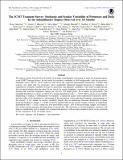Files in this item
The JCMT Transient Survey : stochastic and secular variability of protostars and disks in the submillimeter region observed over 18 months
Item metadata
| dc.contributor.author | Johnstone, Doug | |
| dc.contributor.author | Herczeg, Gregory J. | |
| dc.contributor.author | Mairs, Steve | |
| dc.contributor.author | Hatchell, Jennifer | |
| dc.contributor.author | Chen, Wen-Ping | |
| dc.contributor.author | Kang, Miju | |
| dc.contributor.author | Kang, Sung-Ju | |
| dc.contributor.author | Lee, Jeong-Eun | |
| dc.contributor.author | Morata, Oscar | |
| dc.contributor.author | Pon, Andy | |
| dc.contributor.author | Scicluna, Peter | |
| dc.contributor.author | Scholz, Aleks | |
| dc.contributor.author | Takahashi, Satoko | |
| dc.contributor.author | Yoo, Hyunju | |
| dc.contributor.author | The JCMT Transient Team | |
| dc.date.accessioned | 2018-03-09T12:30:09Z | |
| dc.date.available | 2018-03-09T12:30:09Z | |
| dc.date.issued | 2018-02-08 | |
| dc.identifier | 252504770 | |
| dc.identifier | e5241ebf-bcab-42e3-989e-97555435160a | |
| dc.identifier | 85042411750 | |
| dc.identifier | 000424758700006 | |
| dc.identifier.citation | Johnstone , D , Herczeg , G J , Mairs , S , Hatchell , J , Chen , W-P , Kang , M , Kang , S-J , Lee , J-E , Morata , O , Pon , A , Scicluna , P , Scholz , A , Takahashi , S , Yoo , H & The JCMT Transient Team 2018 , ' The JCMT Transient Survey : stochastic and secular variability of protostars and disks in the submillimeter region observed over 18 months ' , Astrophysical Journal , vol. 854 , no. 1 , 31 . https://doi.org/10.3847/1538-4357/aaa764 | en |
| dc.identifier.issn | 0004-637X | |
| dc.identifier.other | BibCode: 2018ApJ...854...31J | |
| dc.identifier.uri | https://hdl.handle.net/10023/12890 | |
| dc.description.abstract | We analyze results from the first 18 months of monthly submillimeter monitoring of eight star-forming regions in the JCMT Transient Survey. In our search for stochastic variability in 1643 bright peaks, only the previously identified source, EC 53, shows behavior well above the expected measurement uncertainty. Another four sources—two disks and two protostars—show moderately enhanced standard deviations in brightness, as expected for stochastic variables. For the two protostars, this apparent variability is the result of single epochs that are much brighter than the mean. In our search for secular brightness variations that are linear in time, we measure the fractional brightness change per year for 150 bright peaks, 50 of which are protostellar. The ensemble distribution of slopes is well fit by a normal distribution with σ ~ 0.023. Most sources are not rapidly brightening or fading at submillimeter wavelengths. Comparison against time-randomized realizations shows that the width of the distribution is dominated by the uncertainty in the individual brightness measurements of the sources. A toy model for secular variability reveals that an underlying Gaussian distribution of linear fractional brightness change σ = 0.005 would be unobservable in the present sample, whereas an underlying distribution with σ = 0.02 is ruled out. Five protostellar sources, 10% of the protostellar sample, are found to have robust secular measures deviating from a constant flux. The sensitivity to secular brightness variations will improve significantly with a sample over a longer time duration, with an improvement by factor of two expected by the conclusion of our 36 month survey. | |
| dc.format.extent | 21 | |
| dc.format.extent | 3896911 | |
| dc.language.iso | eng | |
| dc.relation.ispartof | Astrophysical Journal | en |
| dc.subject | Galaxies: star formation | en |
| dc.subject | Stars: protostars | en |
| dc.subject | QB Astronomy | en |
| dc.subject | QC Physics | en |
| dc.subject | NDAS | en |
| dc.subject.lcc | QB | en |
| dc.subject.lcc | QC | en |
| dc.title | The JCMT Transient Survey : stochastic and secular variability of protostars and disks in the submillimeter region observed over 18 months | en |
| dc.type | Journal article | en |
| dc.contributor.sponsor | Science & Technology Facilities Council | en |
| dc.contributor.institution | University of St Andrews. School of Physics and Astronomy | en |
| dc.contributor.institution | University of St Andrews. St Andrews Centre for Exoplanet Science | en |
| dc.identifier.doi | https://doi.org/10.3847/1538-4357/aaa764 | |
| dc.description.status | Peer reviewed | en |
| dc.identifier.url | http://adsabs.harvard.edu/abs/2018ApJ...854...31J | en |
| dc.identifier.grantnumber | ST/M001296/1 | en |
This item appears in the following Collection(s)
Items in the St Andrews Research Repository are protected by copyright, with all rights reserved, unless otherwise indicated.

